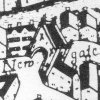St Peter's Hospital
St Peter's Hospital was a building of contrasts. Its riot of decoration was a display of wealth, yet for a long time it housed the poorest of the poor.

Watercolour of St Peter's Hospital from the churchyard in 1894 by Mary Kathleen Moore. It was built as a merchant's house (right) and workplace (left). (Bristol Museum and Art Gallery)
Of all the glories of Bristol lost in the Blitz, one of the most mourned is the exuberant St Peter's Hospital. Built as a merchant's house, it was a showcase of Jacobean architecture. The taste of the time ran to lavish ornament and fanciful figures. Craftsmen had a field day with the façade. The interior was no less ornate.
The building stood between St Peter's churchyard and the River Avon. On the terrible night of 24 November 1940 the whole area was devastated by bombing. Now all that can be seen is the shell of St Peter's Church, standing in Castle Park.
Tucked away down a narrow lane behind the church was not the most obvious place to build a mansion. Yet it had its advantages. It was away from the bustle of the main streets. A river frontage was an asset. The first to make the most of the site was Thomas Norton. He was one of Bristol's merchant princes in the late 14th century, shipping goods to France, Spain and Portugal. Norton bought up three plots to give himself space for a grand mansion. The frontage was over 130ft.
This was the house bought two centuries later by another wealthy merchant, Robert Aldworth, who transformed it into a Jacobean show-piece. His wealth sprang from overseas trade. With an eye to the possibilities of the New World, he played a part in the exploration of northern Virginia. Aldworth was prominent in the Society of Merchant Venturers, whose coat of arms he placed on a fireplace of his new mansion. On the river front he proudly displayed his own monogram and merchant's mark, with the date 1612.

A satyr leers from the façade. Drawn by Hugh O'Neill in 1821. (Bristol Museum and Art Gallery)
The façade facing the church was embellished with the satyrs of Greek and Roman mythology. The effect is far from Classical though. Jacobean builders liked to graft hints of the Renaissance onto sturdy vernacular stock. Inside the house pagan imagery gave way to Christian in a frieze carved with Biblical scenes.
Beside all this domestic display, Aldworth built himself a workshop. He bought adjoining properties, which he rebuilt in a simpler style than his house. He or his heir used this wing as a sugar refinery, so the whole building became known as the Sugar House.
Presumably it was the workshop that appealed to the Corporation in 1696, when looking for a suitable building to use as a mint. The Sugar House was taken over for the purpose. The mint was short-lived. It closed two years later. Yet the name The Mint stuck to the building for decades.
It was also in 1696 that the innovatory Bristol Poor Act established a new body to manage poor relief in the city - the Corporation of the Poor. The driving force behind it was Bristol merchant John Cary. He agitated for the better maintenance and employment of the poor, to replace support by individual parishes. The Bristol Poor Act created of a union of parishes, which could generate enough income to effectively run a workhouse. It was the first Act of its type in the country.
The idea of putting the poor to work was not new. Robert Aldworth left £1,000 in his will for just such a purpose. We can picture his ghost looking on with approval when the Corporation of the Poor decided that his former house was just what they needed. They bought the building after the mint closed. Aldworth's panelled reception room became their boardroom. From then until the Blitz, the house was the headquarters of this body and its successors. Until 1899 it also housed the desperately poor.
At first it was known as the Mint Workhouse, but later became St Peter's Hospital. The word hospital was used in the old sense of a place of refuge, rather than a medical facility, yet it did have an infirmary. Much poverty sprang from illness and disability. The building intended as a workhouse took in children, the aged and lunatics as often as the able-bodied.
Life in the workhouse was far from easy. That was deliberate. The more people struggled to keep out of the place, the lower the charges on the ratepayer. The work was hard and often tedious. Yet it did provide the necessities of life – food and shelter – and by all accounts the food was better than many a labourer's family had. Did it seem odd to live so simply amid the architectural flourishes of a grandee? Sadly there is no-one alive who can tell us.

























